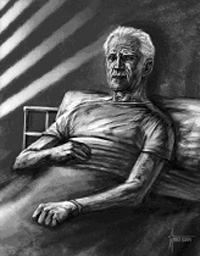
F.O. Vechs in 2004 reminiscing about his
"pointless" contributions to mathematics.


Friedrich Oliver Vechs (1907–2007) is one of those figures one encounters so seldom in the history of mathematics, who made absolutely unremarkable contributions to the field and yet, paradoxically, seems not to have been completely unforgotten. As we approach the centennial of his birth (April 1, 1907), it would be inappropriate not to allow his story to remain consigned to the shadowed alleys of a well deserved obscurity. So apt a sentiment not withstanding, we nevertheless offer the following sketch of his work, although it must necessarily fail to achieve the brevity it deserves.
F. O., as he was known to his contemporaries, had wide-ranging interests in mathematics, although he is probably best known for introducing the construction that today bears his name. Indeed, it is on his account that many a student has been led to observe the role of Vechsation in mathematics.
His earliest work was in logic. For his doctoral dissertation, he developed a set theory that completely eliminated the need for elements. The corresponding developments of analysis and geometry were notable for the absence of the usual Euclidean concept of point. This so called pointless development was later published in the monograph Pointless Mathematics [2].
From the highly abstract and formal to the utterly mundane, Vechs also took an interest in applications. Even as a graduate student he initiated a series of investigations in economics [3]. However, a somewhat less obvious case of insignificance which has been largely forgotten by later mathematicians is his work on the Linear Theory of Bending (LTB) [4]. Indeed, this work would probably be completely unknown today but for the scholarship of Yuster and Billie [10].
In LTB, the object is to decompose plane curves, the better to analyze
their geometric properties. The theory employs two fundamental
operators, B and S (prompting some authorities to therefore refer to LTB
as the BS theory) with the following properties:
|
The orthogonality conditions in the LTB led F. O. to consider orthogonality again later in even greater superficiality. Given a completely abstract mathematical entity S, Vechs introduced the notion of the orthogonal bundle ⊥[S] (read "perp S"). Owing to an unfortunate accident at the typesetters, the feet were somehow left off of the brackets in the original publication [5], and later commentators always wrote this notation as ⊥⌈S⌉. Vechs himself refused to use the modified notation, observing that it de-feets the perp S, but the notation somehow took on a life of its own, and he was never able to rectify the problem. Sadly, this happenstance was a constant source of irritation for Vechs, and he ultimately completely abandoned further work in the area.
His work with linear operators inescapably led Vechs to matrix theory. Here, he applied his usual innovative methods to discussing determinants. Up to that time, determinants were invariably formulated as a function of the columnses of a matrix. But the Swiss mathematician Rade, whose earlier work in this area was unknown to the modern practitioners, had originally formulated determinants in terms of the rowses of the matrix. Always one to inject an element of confusion into an otherwise orderly discussion, Vechs resurrected Rade's approach and argued vehemently for an alternate definition of determinant. This is remembered dimly, when at all, as determinant of rowses (per Rade). Aside from an annual commemorative celebration in Pasadena, however, this work is largely forgotten.
Finally, while any survey of F.O.'s work would be less incomplete than no survey at all, at least some mention of his work in combinatorics seems superfluous. Nevertheless, let us consider just one topic he studied, derangements [6]. Vechs was fascinated by meaningless abstraction, and so studied not only derangements themselves, but linear operators on derangements Hom(Derange), as well as linear operators on the operators Hom(Hom(Derange)). He discovered the covariant loop structure that is not so well known today as to garner any attention at all, and also the contravariant anti-loop structure. His most important contribution was a completely anharmonic rendition of Hom-Hom on Derange, where θr and the anti-loop play, remarkably enough, fundamental roles.
Throughout mathematics, the contributions of this unsung innovator are inescapable. Even at the most elementary level, it is hard to imagine any treatment of calculus or precalculus without at least mentioning F. O. Vechs. His older children George (always called Geo Vechs) and Helen Olga (H. O. Vechs) are also frequently mentioned in these subjects (see, e.g., [8]), as are the younger twin daughters, Emma and Pia, who studied polynomials [9]. Another relative, F. Rado Vechs, was a mathematics educator who was among the first to recognize mathematics anxiety [7]. And his graduate students Teo Vahr and L. Ovess also are frequently encountered in calculus, particularly in connection with polar coordinates and arclength parameterization [1]. These many contributions are worthy of mention on this anniversary of his birth, before being permitted to regain their rightful position, so richly deserved, among the forgotten relics of mathematics.